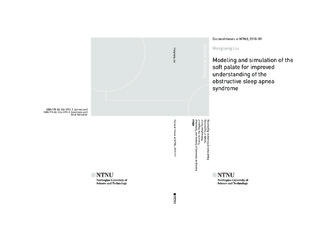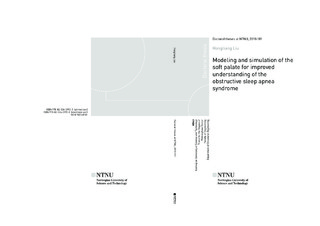| dc.contributor.advisor | Skallerud, Bjørn Helge | |
| dc.contributor.advisor | Prot, Victiorian Emilie | |
| dc.contributor.author | Liu, Hongliang | |
| dc.date.accessioned | 2018-04-19T11:18:14Z | |
| dc.date.available | 2018-04-19T11:18:14Z | |
| dc.date.issued | 2018 | |
| dc.identifier.isbn | 978-82-326-2993-0 | |
| dc.identifier.issn | 1503-8181 | |
| dc.identifier.uri | http://hdl.handle.net/11250/2495063 | |
| dc.description.abstract | Obstructive sleep apnea (OSA) influences a large part of the population and is increasingly recognized as a major global health problem. For OSA patients, the collapse of the soft palate has been clarified to be a common feature for the obstructive breathing. A comprehensive study of the biomechanical mechanism underlying the soft palate collapse is needed to obtain a deep insight of the mechanical mechanism in the OSA process. To address this challenge, beginning from the 3-dimensional (3D) patient-specific model, series work has been done to investigate the global response of the soft palate. First, based on the corresponding histology study and the corresponding quantitative tissue composition analysis, a tissue composition based model was created, including three main tissue layers: posterior pharynx supersurface adipose tissue layer, medial muscle tissue and connective tissue layer and the anterior oral surface glandular tissue layer. Specific material properties were assigned to each specific tissue layer considering the nonlinear property and anisotropic behavior. Nonlinear behavior of the global response of the soft palate in response to the negative pressure loading on the upper airway was presented. Second, in order to investigate the palatal implant surgery efficacy for improving the patients' sleep condition, pillar placement numerical simulation with 3D patient-specific geometry was achieved. The Young's modulus of the pillar implants material was obtained through performing a uniaxial test with some implants samples. A new surgery scheme that implanting the pillars in the transverse direction was provided, and its strengthening efficacy was tested to be higher than the current longitudinal surgery scheme based on the numerical simulation results. Then, a phenomenological constitutive model was developed to represent the palatal muscle activation mechanism working to maintain the upper airway patency when the negative pressure is produced. OSA patients' muscle activation defectiveness was verified in the palatal muscle activation numerical simulation, in which the created constitutive model was considered. In addition, based on the experiment data published in the literature, the cohesive approach combined with the created 3D geometry was used to investigate the influence of the adhesion effect from the lining liquid between the soft palate and the tongue on the global response of the soft palate. The cohesive properties were obtained through fitting the numerical simulation results to the experimental test data. Finally, a new anisotropic finite strain viscoelastic model was presented, based on the Holzapfel type anisotropic hyperelastic strain-energy function. A new method to develop the evolution equations of the internal variables was presented. The corresponding analytical validation for positive dissipation energy, using the second law of thermodynamics, was also provided. Some numerical simulations were achieved, and the proposed constitutive model was tested to represent the anisotropic viscoelastic behavior efficiently. This might lie a guide for future investigations of the soft palate's viscoelastic behavior. In the future study of the soft palate or solid mechanics research for the OSA, more anatomical and physiological numerical simulation is needed, in order to provide more useful information to the clinical research and to facilitate some operations in the clinical surgery. This current thesis provides a basic framework and presents comprehensive knowledge for further more physiological study of the OSA. | nb_NO |
| dc.language.iso | eng | nb_NO |
| dc.publisher | NTNU | nb_NO |
| dc.relation.ispartofseries | Doctoral theses at NTNU;2018:101 | |
| dc.relation.haspart | Paper 1: Liu, Hongliang; Prot, Victorien Emile; Skallerud, Bjørn Helge. Tissue composition based nonlinear FEM simulation of the soft palate using patient specific 3D anatomy. I: MekIT’17 - Ninth national conference on Computational Mechanics. International Center for Numerical Methods in Engineering (CIMNE) 2017 ISBN 978-84-947311-1-2. s. 191-214 | nb_NO |
| dc.relation.haspart | Paper 2: Liu, Hongliang; Moxness, Mads Henrik Strand; Prot, Victorien Emile; Skallerud, Bjørn Helge. Palatal implant surgery effectiveness in treatment of obstructive sleep apnea: a numerical method with 3D patient-specific geometries. Journal of Biomechanics 2018 ;Volum 66. s. 86-94
https://doi.org/10.1016/j.jbiomech.2017.11.006 | nb_NO |
| dc.relation.haspart | Paper 3: Soft palate muscle activation: a modeling approach for improved understanding of obstructive sleep apnea . Hongliang Liu, Victorien Emile Prot, Bjørn Helge Skallerud
- Is not icluded due to copyright | nb_NO |
| dc.relation.haspart | Paper 4: 3D patient-specific numerical modeling of the soft palate considering adhesion from the tongue. Hongliang Liu, Victorien Emile Prot, Bjørn Helge Skallerud
- Is not icluded due to copyright | nb_NO |
| dc.relation.haspart | Paper 5: Anisotropic finite strain viscoelasticity - constitutive modeling and finite element implementation
- Is not icluded due to copyright | nb_NO |
| dc.title | Modeling and simulation of the soft palate for improved understanding of the obstructive sleep apnea syndrome | nb_NO |
| dc.type | Doctoral thesis | nb_NO |

